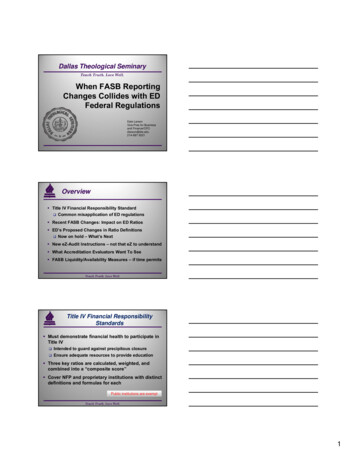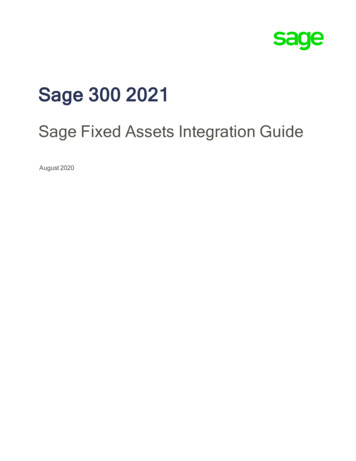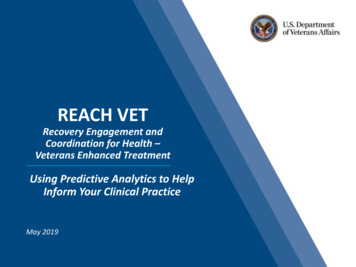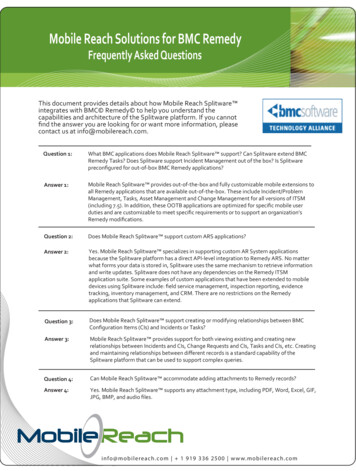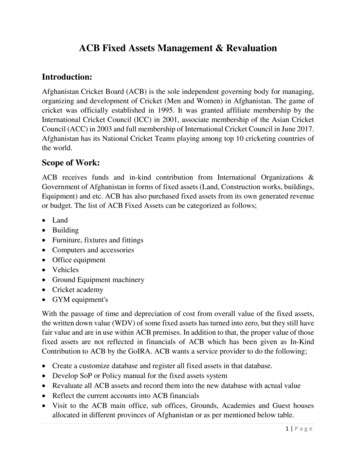
Transcription
Within ReachA Policy Roadmap for Dual Credit in IndianaJennifer Zinth June 2022ZINTH CONSULTING, LLC
Table of ContentsIntroduction3Development of This Report4Equity Goal and Public Reporting6Unlocking Potential’s Call to Action2021 CHE Early College Credit Report RecommendationIndiana Policies That Relate to These MetricsRecommendationsProgram Integrity and Credit Transfer8Unlocking Potential’s Call to Action2021 CHE Early College Credit Report RecommendationIndiana Policies That Relate to These MetricsRecommendationsFinance10Unlocking Potential’s Call to ActionIndiana Policies That Relate to These MetricsRecommendationsCourse Access and Availability13Unlocking Potential’s Call to ActionIndiana Policies That Relate to These MetricsRecommendationsInstructor Capacity16Unlocking Potential’s Call to Action2021 CHE Early College Credit Report RecommendationIndiana Policies That Relate to These endations: InnovateNavigational Supports20Unlocking Potential’s Call to Action2021 CHE Early College Credit Report RecommendationIndiana Policies That Relate to These MetricsRecommendationsConclusionWithin Reach: A Policy Roadmap for Dual Credit in Indiana23
Executive SummaryThe Indiana Commission for Higher Education (CHE) 2021 Early College Credit Report notesever-increasing numbers of Hoosier graduates earning dual credit, resulting in significantpotential tuition cost savings to families, and greater rates of on-time or early college graduationfor participating students. However, the report also identifies inequities in dual credit participationby student race and ethnicity, family income and geographic region of the state.To support efforts to address these challenges, the Joyce Foundation engaged Jennifer Zinth, anationally recognized dual credit state policy expert, to develop the present report synthesizingthe insights of statewide dual credit stakeholders on barriers to equitable dual credit access,participation and success in Indiana, as well as recommendations to address identifiedchallenges. The six policy categories in the College in High School Alliance Unlocking Potentialreport served as a framework for these discussions. The goal is for state and local policymakersto use this report to inform future policy actions to enhance equity in dual credit availability,access and success.Three cross-cutting policy levers emerged from this research:1. Indiana Dual Credit Advisory Council: A reconvened council could consider ways forprograms to receive the funding necessary to ensure program integrity and assess viablealternatives to the current dual credit funding model.2. A statewide equity goal for dual credit participation: A statewide equity goal wouldbe a critical tool in efforts to identify and address equity gaps in dual credit access andparticipation and apply college course-taking in high school to further efforts to decreasedemographic gaps in postsecondary success measures.3. Scaling the Indiana College Core in high school: The Indiana College Coreestablishes 30 college credit hours guaranteed to transfer to public institutions statewide.While awareness of the program is growing with key audiences such as high schoolstudents, parents, teachers, counselors and administrators, many such individualsare as of yet minimally aware or not aware of Indiana College Core opportunities andadvantages.Leading recommendations also came forward from each Unlocking Potential policy category:1. Equity Goal and Public ReportingProvide and utilize more detailed student participation and outcomes data: Such datacan shed light on geographic disparities in equitable dual credit course availability; andstudent participation, success and future employment outcomes.2. Program Integrity and Credit TransferEnhance and broadly communicate the TransferIN website: Stakeholders noted alack of awareness of the TransferIN website among many students, parents, teachers andcounselors, and particularly among first-generation students and their families.3. FinanceEnhance communication to legislators on the value and benefit of dual credit courses:State funding does not cover institutions’ dual credit course delivery costs. Sustaining orincreasing the state’s financial commitment to dual credit implies ensuring that legislatorsWithin Reach: A Policy Roadmap for Dual Credit in Indiana3
understand the return on the state’s biennial investment in priority and Career and TechnicalEducation (CTE) dual credit courses.4. Course Access and AvailabilityDevelop and disseminate tools for local secondary and postsecondary partners to identifyand address root causes contributing to inequities in course availability, participation andsuccess: To date no statewide tools have been developed to help local stakeholders identify andaddress root causes of lower participation rates among some student subgroups.5. Instructor CapacityCreate a menu of additional state and local up-credentialing strategies: Approaches inaddition to STEM Teach and Teach Dual Credit Indiana could support dual credit credentialingof individuals not yet in – or working their way through – the teacher credentialing process orpursuing (or even considering) a master’s degree to move up on step and lane salary schedules.6. Navigational SupportsCreate a menu of additional state and local up-credentialing strategies: Approaches inaddition to STEM Teach and Teach Dual Credit Indiana could support dual credit credentialingof individuals not yet in – or working their way through – the teacher credentialing process orpursuing (or even considering) a master’s degree to move up on step and lane salary schedules.IntroductionLast year, the Indiana Commission for Higher Education reported that sixty percent of Indiana’sgraduating high school Class of 2018 earned dual credit, making Indiana a national leader in thenumber of high school students completing college credits. Over the last decade, Indiana hasalso seen significant growth in the number and percentage of underrepresented students takingdual credit, and the number of Indiana Core Credentials being earned.Yet in spite of this growth, state data identify disparities in dual credit participation by studentbackground. As noted in CHE 2021 Early College Credit report, low-income students and Blackand Hispanic/Latino students are less likely than white students to take dual credit courses. While38 percent and 50 percent of Black and Hispanic/Latino students in the high school Class of2018 graduated having earned at least one college course, respectively, 65 percent of white 2018high school graduates had earned dual credit. Forty-nine percent of low-income members of thehigh school class of 2018 had earned dual credit, compared to 66 percent of non-low-incomehigh school graduates.In addition, state data also bear out notable differences in who participates in dual credit courses.There are:Geographic disparities in the percentage of Indiana high school students graduating withdual credit. Although state statute requires all high schools to offer at least two dual creditcourses and at least two Advanced Placement (AP) courses, the percentage of studentsby school district earning AP or dual credit by high school graduation ranged from 49percent to 86 percent for the Class of 2018.Demographic disparities in students earning technical-only versus priority liberal artsonlydual credit. Thirty-two percent of dual credit-earners completed technical-only dualWithin Reach: A Policy Roadmap for Dual Credit in Indiana4
credit, 38 percent earned priority-only dual credit, and 30 percent earned both technicaland priority dual credit. However, technical-only dual credit students are more likely to beBlack or Hispanic/Latino than their peers, and significantly more likely to be low-income.Research has consistently demonstrated that dual credit courses help students get ready forthe next chapter after graduating high school, so high school Hoosiers have a lot to gain byparticipating in dual credit and taking courses that help them cultivate skills and interests thatwill allow them to fully contribute to the local economy and 21st century society. State and localpolicymakers and administrators in Indiana can and do play a critical role in making this happen.Informed by interviews and input from dozens of leaders in Indiana education who are deeplyengaged in dual enrollment policy and practice, this report summarizes recommendations on howto move forward. These recommendations underscore three key actions that the Commission forHigher Education and the Indiana Department of Education can take in partnership with state andlocal policymakers and administrators:Reconvene Indiana’s Dual Credit Advisory Council.Set a statewide equity goal for dual credit participation.Continue to promote the value of the Indiana College Core for high school students.By taking these steps, Indiana leaders can help ensure that dual credit, and by extension,postsecondary preparedness is within reach for high school students across the state.TerminologyEarly college credit is college credit that is earned while a student is in high school. Thesecredits can be earned through “college in high school” programs like Dual Credit, AdvancedPlacement, and International Baccalaureate.Dual credit courses are taught at a high school by a high school teacher for early college creditthrough a formal agreement with the high school and a college or university. There are two typesof state-funded dual credit courses:Priority Liberal Arts, which includes English, mathematics, science, and worldlanguagesTechnical, which includes health sciences, information technology, and manufacturingDual enrollment courses are also taken by high school students for early college credit but aretaken at a college campus or online and are taught by faculty at the college or university.Indiana College Core is a 30-hour block of general education courses that transfers at all publiccolleges and universities in Indiana.Within Reach: A Policy Roadmap for Dual Credit in Indiana5
Development of This ReportThe goal of this report is to identify a menu of recommendations from which state and localleaders can choose to adopt and implement to expand opportunities for students, particularly underrepresented in rigorous coursework, to access and succeed in dual enrollment courses. Thisreport was underwritten with generous support from the Joyce Foundation, and provided extensive staff support by Ken Sauer, Senior Associate Commissioner and Chief Academic Officer andTari Lambert, Director, Transfer Indiana, of the Indiana Commission for Higher Education.The recommendations in this report were informed by numerous secondary and postsecondarydual credit stakeholders from across Indiana. Stakeholders include state agency staff and localstakeholders engaged in dual credit policymaking and implementation efforts.Dual Credit Stakeholder Group MembersAndy Allen, Principal, Batesville HighSchoolDrew Findlay, Dean of CTE Early College,Vincennes UniversityMichael Ball, Assistant Vice President forSchool Partnerships and Senior AssistantVice Provost for Undergraduate Education,Indiana UniversityTony Harl, Assistant Director of Careerand Technical Education, Governor’sWorkforce CabinetPatrick Biggerstaff, Director of Careerand Technical and Adult Education, Area31 Career CenterJanet Boyle, Director of RECN, Centerof Excellence in Leadership of Learning(CELL), University of IndianapolisJason Callahan, Assistant Secretary ofStudent Pathways and Opportunities,Indiana Department of EducationCarey Dahncke, Executive Director,CELL, University of IndianapolisOdelet Nance, Assistant Dean ofInstruction, Vincennes UniversityAudra Peterson, Director of Porter CountyCareer and Technical Education, PorterCounty Career and Technical EducationRebecca Rahschulte, Vice-Presidentof K-14 Initiatives and StatewidePartnerships, Ivy Tech Community CollegeNicole Shankle, Dean of Academic EarlyCollege, Vincennes UniversityEach stakeholder group member participated in a one-hour virtual interview to elicit theirthoughts on dual equity opportunities and challenges on each of the six policy components in theUnlocking Potential framework for high quality, equity-centered dual credit policy. The challengesand opportunities elevated in these interviews were synthesized into draft recommendationsthat stakeholders responded to during a January 2022 virtual meeting. The draft challenges andrecommendations were revised based on feedback gathered during this meeting. Stakeholdergroup members and members of a broader dual credit Resource Group (listed below) wereinvited to review and invite members of their networks to review and provide feedback on thedraft report.Within Reach: A Policy Roadmap for Dual Credit in Indiana6
Dual Credit Resource Group MembersTodd Bess, Executive Director, IndianaAssociation of School PrincipalsTracy Butler, Senior Coordinator, PostSecondary Readiness, CELL, University ofIndianapolisMichelle Clarke, Assistant Director ofCollege and Career Engagement, IndianaDepartment of EducationGreg Hinshaw, President, IndianaAssociation of Public SchoolSuperintendentsJen O’Shea, Post-Secondary ReadinessOfficer, Indianapolis Public SchoolsKhalid Reichard, Early CollegeCoordinator, Muncie Central High SchoolStephanie Ebbing, Assistant Principal,Jennings County High SchoolMark Schneider, Assistant VP of K-14Initiatives & Statewide Partnerships, IvyTech Community CollegeJohn Elcesser, Executive Director,Indiana Non-Public Education AssociationD’Lee Thomas, Project Excel ProgramCoordinator, Vincennes UniversityJody French, Principal, Perry CentralJunior/Senior High SchoolTrish Wlodarzyk, Director of StrategicInitiatives, CELLDoug Harter, Assistant Principal, HamiltonSoutheastern High SchoolGail Zaheralis, Director of GovernmentRelations, Indiana State TeachersAssociationSandy Hillman, Director of Early College,CELLAn overview of the draft report was also presented to leaders of the Indiana Department ofEducation and the Indiana Commission for Higher Education in a virtual February 2022 meetingand revised again based on feedback gathered from these leaders.This report provides:A description of each Unlocking Potential policy component and a call to action thatstates should be working towards to achieve equity and quality for high school programsin their stateWhere applicable, a reference to an aligned recommendation from CHE’s most recentEarly College Credit ReportA summary of Indiana policies relevant to the Unlocking Potential policy componentState and local policy recommendationsRecommendations in this report reflect stakeholder input. However, this is not a consensusreport.Within Reach: A Policy Roadmap for Dual Credit in Indiana7
Equity Goal and Public ReportingUnlocking Potential’s Call to ActionStates set an equitable, statewide public goal for increasing the participation and successof traditionally underserved student groups in college in high school programs, with clear,disaggregated public reporting and accountability for progress toward the goal.2021 CHE Early College Credit Report RecommendationEmphasize transparency and data collection at the high school level.Define “Equity” for Purposes of Dual Credit ParticipationTo address the recommendations presented below, Indiana should define “equity” for purposesof dual credit participation, including by diverse geography, low-income, and students fromdiverse racial/ethnic backgrounds. The Funding for Equity report notes: “Dual enrollment equitymeans that the student population in a state’s dual enrollment program mirrors the demographic,socioeconomic and geographic diversity of the state’s overall K-12 student population. If a state’sK-12 population is 20 percent African American, 30 percent rural, and 50 percent eligible for freeand reduced-price lunch, the dually enrolled student population in a state that has achieved dualenrollment equity is 20 percent African American, 30 percent rural, and 50 percent eligible forfree and reduced-price lunch.”Indiana Policies That Relate to These MetricsPostsecondary Attainment GoalIndiana has set a postsecondary attainment goal: By 2025, 60 percent of workingage Hoosiers will have a quality degree or credentialThe Commission for Higher Education (CHE) 2020 strategic plan includes dual creditamong strategies to increase postsecondary attainmentThe 21st Century Scholars Program which provides up to four years of tuition toincome-eligible students who meet certain requirements throughout high schoolPublic ReportingCHE’s biennial early college credit report provides valuable information on dual creditaccumulation and postsecondary outcomesCHE publishes institution-level attainment dataIndiana Graduates Prepared to Succeed (GPS) InitiativeProposes AP/IB/Dual Credit/Cambridge AICE/CLEP as headline indicatorsA related Indiana Department of Education dashboard is currently underdevelopmentWithin Reach: A Policy Roadmap for Dual Credit in Indiana8
RecommendationsEstablish a statewide equity goal on dual credit participationRationale: Indiana currently lacks a statewide dual credit equity goal. A statewideequity goal would be a critical tool in efforts to identify and address equity gaps indual credit access and participation and apply college course-taking in high schoolto efforts to decrease demographic gaps in postsecondary aspirations, matriculation,and on-time completion.A statewide equity goal might serve as a catalyst for:State and local discussions between secondary and postsecondarystakeholders on resource allocation and support: Such discussions wouldincrease the number of students of color, low-income, and first-generationstudents succeeding in dual credit course offerings.More endorsed early colleges in urban communities: Dual creditparticipation and postsecondary matriculation are particularly lagging inIndiana’s urban communities. A statewide equity goal might provide a rationalefor the establishment of more urban early colleges, which in turn would supportpostsecondary aspirations, preparation, and participation among historicallyunderserved students. IDOE is funding the Urban College AccelerationNetwork, an initiative of the University of Indianapolis’ Center for Education ofthe Leadership of Learning (CELL) to increase the number of early colleges inunderserved urban communities.State and local efforts to identify and address the root causes of the“leaky postsecondary pipeline”: According to the Indiana Department ofEducation, while 79 percent of Indiana high school seniors expect to go on topostsecondary education, just 59 percent of recent high school graduates do so.Of those, only 1 in 4 complete any postsecondary credential four years after highschool graduation.Help students connect the dots between students’ career goals whileincreasing certificate or two-year degree completion: Many studentsperceive of “college” only as educational experiences in a four-year institution.These students may not be pursuing a postsecondary education at all, whena certificate or associate’s degree would help them achieve their career goalsand help Indiana achieve its postsecondary attainment goal. Efforts to enrollsuch students in applicable dual credit courses of interest would help them. Astatewide equity goal with a sub-focus on dual credit as a pathway to certificateassociate degree completion might enhance efforts to define career paths interms of stackable credentials.Invest in and publish state-level research identifying root causescontributing to inequities in dual credit access, participation, and successProvide and utilize more detailed student participation and outcomes data.Rationale: Such data can shed light on geographic disparities in equitable dualcredit course availability; and student participation, success and future employmentoutcomes.Potential uses of more detailed public-facing information might include:Sustaining financial support and demonstrating the return on investment for dualcredit.Within Reach: A Policy Roadmap for Dual Credit in Indiana9
Comparing dual credit/non-dual credit postsecondary matriculation rates andpostsecondary outcomes by student demographics, including by gender.Comparing postsecondary and employment outcomes of students earning apostsecondary credential upon high school graduation. Such credentials mightinclude the Indiana College Core (ICC), a postsecondary certificate, or anindustry-recognized credential.Utilizing data for local dual credit partners to identify and address equity gapsand facilitate difficult conversations. While K-12 and postsecondary partners arerequired to report dual credit participation data, they are not required to reviewparticipation data to identify demographic disparities between the overall highschool population and the dual credit population. Such analysis might inform andcatalyze local efforts to work towards parity in the demographics of the overallhigh school population and the dual credit population.Improving linkages between existing K-12 and postsecondary data to identifywhat experiences in middle schools and high schools correlate with a greaterlikelihood of students earning certificates and postsecondary degrees.Program Integrity and Credit TransferUnlocking Potential’s Call to ActionStates support and promote high-quality college in high school programs through effectiveoversight and cross-sector collaboration between the K-12 and postsecondary sectors, as well asensuring credit articulation.2021 CHE Early College Credit Report RecommendationsEmphasize transparency and data collection at the high school level. Utilize search tools (such asthe Learn More Indiana School Finder Tool, the Indiana Credential Registry and Indiana CareerExplorer) to seek out postsecondary credential opportunities.Indiana Policies That Relate to These MetricsEnabling credit transfer and equivalency with college courses.The Core Transfer Library identifies courses that will transfer across publicinstitutions statewide.The Indiana College Core establishes 30 college credit hours guaranteed to transferto public institutions statewide.The Transfer Single Articulation Pathways (TSAPs) are “competency-based degreetracks designed to promote seamless transfer from a public 2-year to a public 4-yeardegree program. These were aligned with program areas that have significantenrollment numbers by students who may first obtain an associate of science oran associate of arts degree. In most cases, completion of a TSAP also involvescompletion of the Indiana College Core.”AP/IB/CLEP/Cambridge postsecondary equivalenciesWithin Reach: A Policy Roadmap for Dual Credit in Indiana10
Next Level Programs of Study (NLPS) allow students to experience greaterconsistency and quality in CTE programming statewide.Ensuring program quality and rigor.Public postsecondary institutions are eligible for a biennial partial reimbursementfrom the legislature based on credit hours successfully earned in priority and Careerand Technical Education (CTE) dual credit courses – but only if programs are accredited by the National Alliance of Concurrent Enrollment Partnerships (NACEP) orsuccessfully undergo a similar review process by CHE.The CHE/CELL early college endorsement process ensures program quality andprovides support to programs seeking endorsement.Cultivating cross-system collaboration.The NACEP standards – which all Indiana dual credit programs adhere to – requirean agreement to be established between secondary and postsecondary partnersidentifying the roles and responsibilities of each partner.To be approved as an Indiana College Core delivery site, an agreement must be inplace between the high school and primary postsecondary partner, in accordancewith the state criteria for designating a high school as a delivery site for the IndianaCollege Core.RecommendationsPROGRAM INTEGRITYEngage the Dual Credit Advisory Council and CHE, DOE leadership to re-evaluatethe secondary and postsecondary funding structure necessary to ensure programintegrity.Rationale: While vital, institutional efforts to maintain program integrity are time- andresource-consuming. As of May 2022, postsecondary institutions receive roughly 45 per credit hour to partially reimburse costs associated with delivering priorityand CTE dual credit courses. This reimbursement falls far short of the actual costspostsecondary institutions incur in supporting dual credit coordinators and facultyliaisons in delivering NACEP-required teacher professional development and sitevisits, and providing academic and non-academic supports to students, to name justa few expenses postsecondary partners incur in delivering dual credit. Secondarypartners receive no additional funding but must cover additional costs as well inproviding dual credit coursework.Establish and highlight statewide best practice guidelines for collaborativepartnerships.Rationale: While all public postsecondary institutions must adhere to the NACEPguidelines, significant variation exists, for example, in faculty liaisons’ engagementwith high school teachers over the course of the school year, presenting the potentialfor uneven support for high school teachers and jeopardizing course rigor. Statewideguidelines might identify best practices in delivering high school teacher professionaldevelopment (including the duration and quality measures of those professionallearning opportunities); facilitating faculty/high school instructor collaboration; and achecklist of key responsibilities for faculty liaisons.Within Reach: A Policy Roadmap for Dual Credit in Indiana11
Establish a standard dual credit MOU template.Rationale: While the specifics of which partner covers which programmatic aspects(and how) may vary, a standard dual credit MOU template can ensure that programsensure rigor and are clear on the respective roles and responsibilities of the K-12and postsecondary partners.CREDIT TRANSFEREnhance and broadly communicate the TransferIN website.Rationale: Stakeholders noted a lack of awareness of the TransferIN websiteamong many students, parents, teachers, and counselors, and particularly a lackof awareness among first-generation students and their families. Stakeholdersadded that the website is not very user-friendly to students, parents, and guidancecounselors. They also observed that while TransferIN is regularly updated, it isunclear to external users how often the website is updated.A revised TransferIN website might include tools for students to advocate forthemselves when seeking to confirm whether and how a specific course mighttransfer to an institution.Highlight best practices on institutional transfer websites.Rationale: Stakeholders pointed to significant variation on Indiana institutions’transfer websites and encouraged greater transparency and consistency oninstitution websites on how courses will transfer. CHE can play a role in identifyingand elevating examples of websites that clearly and effectively communicate tostudents and other stakeholders whether and how dual credit courses will transferand apply to programs of study.FinanceUnlocking Potential’s Call to ActionStates design funding mechanisms that remove financial barriers for low-income and moderateincome students to participate and excel in college level work in high school.Indiana Policies That Relate to These MetricsState policy caps dual credit tuition at 25 per credit hour for priority liberal arts and CTEcourses and does not limit the number of courses or credits students may take at thistuition rate.State policy waives dual credit tuition for low-income students. Institutions are authorizedto waive dual credit tuition for non-low-income students.Ivy Tech does not charge dual credit tuition to any students, regardless of family income.The state funding model creates student “skin in the game.” Requiring students to paymodest costs incentivizes them to take seriously the opportunity to complete collegecourses in high school.Within Reach: A Policy Roadmap for Dual Credit in Indiana12
Public postsecondary institutions receive a biennial allocation based on reportedsuccessful student course completion in priority and CTE dual credit courses. Thesefunds are intended to defray the cost of lost tuition revenue, professional development,and program oversight costs.The state disburses funds to postsecondary institutions for each high school student whocompletes an approved certificate or degree.Career centers and institutions may apply Perkins funds towards various CTE dual creditcourse expenses, including teacher professional development, equipment, facilities,curriculum, tutoring, textbooks, and speakers.Like other postsecondary certificates, Indiana College Core completions are included inthe postsecondary incentive funding model.RecommendationsSTATEWIDEPromote the value and benefit of dual credit courses.Rationale: State funding does not cover institutions’ dual credit course deliverycosts. Sustaining or increasing the state’s financial commitment to dual credit impliesensuring that legislators understand the return on the state’s biennial investment inpriority and CTE dual credit courses.Encourage:The Dual Credit Advisory Council and CHE, DOE leadership to assess viablealternatives to the current dual credit funding model.Rationale: CHE’s 2021 Early College Credit report notes gains in thepercentage of high school students earning college credit. Yet the state dualcredit appropriation has dropped from 50 per credit hour to 45 per credit hourin the 2021-23 biennium. Institutions’ dual credit expenses are manifold. Risingdual credit enrollments should be matched by increased funding to sustainequitable access while maintaining program quality.A CHE annual report and recommendations could lay the foundation forincreased biennial appropriations. An annual report might document t
State policy caps dual credit tuition at 25 per credit hour for priority liberal arts and CTE courses and does not limit the number of courses or credits students may take at this tuition rate. State policy waives dual credit tuition for low-income students. Institutions are authorized to waive dual credit tuition for non-low-income students.



